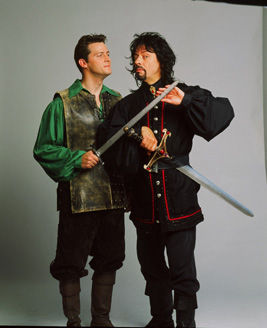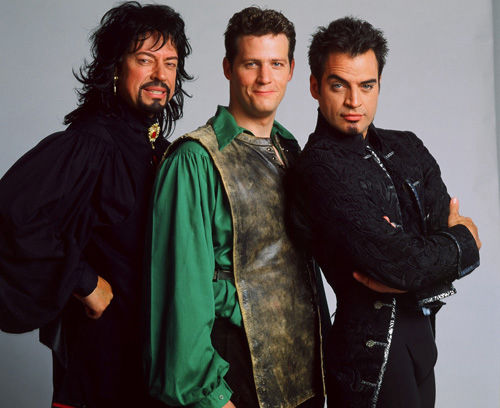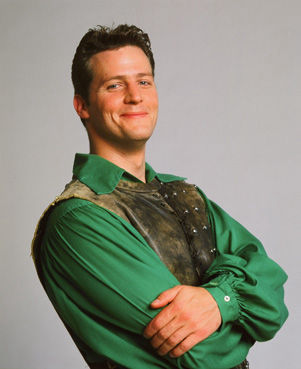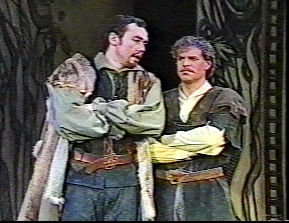Heroes and Villains
Graham Abbey makes a pleasant enough Robin Hood, but really that's all the script allows him to be. Pleasant and boy-scout heroic. Abbey did injure his tendon before opening night performance and so he didn't have a chance to swash his buckler as much as the script originally called for. But then, I don't think it is truly action that this Robin Hood is lacking. What he lacks is what Stephen Knight calls trickster vitality. True, Robin does engage in some classic disguises (an old woman as in the ballad Robin Hood and the Bishop and homage-named Geiser of Gisborne at the archery contest.) But rather than a form of natural justice, Robin is merely normal society in exile -- Uncle Robin, as this version of hero has been called. I feel like something has been lost in the legend, but what do I know? When asked who their favourite character was, most of the kids said Robin.
It's probably treason for a Robin Hood webmaster to admit this, but I was really rooting for the bad guys (which in pantos take the form of boos and hisses, not applause). This won't come as any surprise to the adults who have been to a pantomime. The bad guys almost always steal the show. Their comments are the most cutting, they break the fourth wall the most, and there's a genuine sense of enjoyment from them. That tricksterish, anti-authoritarian spirit that was once Robin's, now belongs to villains.
There are 2.5 bad guys in this production (1.5 in the 1996 version). The head bad guy is, naturally, the Sheriff of Nottingham played by Ross Petty, the show's producer and guiding force. Petty's sheriff borrows his dress sense and demeanour straight from Alan Rickman's sheriff in Prince of Thieves. (A sort of quid pro quo as Rickman was essentially playing a panto bad guy.) In one of his first scenes, the sheriff establishes his draconian rules. "No cellphones.... during my scenes. Make all the calls you want when someone else is on stage." A veteran panto actor/producer, Petty knows exactly how to get the audience to boo and hiss.
Then, there's the .5 villain, Simon Bradbury as the seemingly dimwitted lackey Pinch. I was happy to see Bradbury mentioned in the 2002 publicity poster, because he was my favourite part of the earlier production. His character holds some delightful surprises -- at least, for those who haven't seen the 1996 version. In particular, I remember the scene where the sheriff recruits Pinch to be pretty much unchanged from the show's earlier incarnation.
While Petty and Bradbury are veterans, a newcomer (both actor and character) to the 2002 version is Rex Harrington, straight from the National Ballet of Canada. As the Bad Wizard (or "Bad Fairy" as the children of the audience quickly dubbed him, despite the cast's corrections), he dances beautifully across the stage, but more surprisingly delivers bilious bon mots with the best of them. There's a spark every time Harrington appears, which is not nearly as often as he should. When asked who his character is supposed to be, the Wizard declares "If you have to ask, you haven't been to my website recently!" Evil wizards may seem to be straight out of the 80s TV show, Robin of Sherwood, but they've been popping up in Robin Hood pantos since the 1800s.
Two more stock characters from panto tradition are the Good Fairy (like godmothers of other pantos) and the Dame, called here Nurse Tickle. Sara Topham plays Harrington's opposite numbers, and they duel with both magic and musical numbers (such as "Anything You Can Do, I Can Do Better" from Annie Get Your Gun). But there's some sizzle in these characters as they go from waltzes to tangos. The whole "spirit of the forest" thing is a bit on the saccharine side for this grumpy grown-up, but Topham does fairly well. (Karen Kain -- Ross Petty's wife and former ballet partner of Harrington -- played the role in 1996.)
As for Nurse Tickle, Nora McLellan is a surprising although entertaining choice -- that's because she's a woman. Traditionally, the part of the dame is played by a fella. (In the 19th century, Robin Hood, the Sheriff and Alan a Dale were all played by women in pantos.)
After them, there's not much left for the Merry Men to do. Marian (Amy Walsh) is, naturally, the love interest and a damsel in distress, but also thankfully she does don the lincoln green and join the band. The other Merry Men don't even merit mention in the show's publicity material. Tuck gets a few more lines as the sheriff's chaplain who is more than happy to switch sides. But Little John, Will Scarlet and Alan a Dale share only a few lines and are not much different from generic Merry Men 1 or 2. Scarlet faired better in the 1996 where he was portrayed by ballet dancer Frank Augustyn. But here it is Harrington's bad wizard who supplies the dance and romantic interaction with the good fairy.




Contact Us